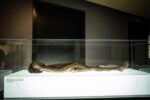Fan Zeng – La sinfonia delle civiltà
.jpg)
il Complesso del Vittoriano di Roma ospiterà la prima grande mostra monografica in Italia dedicata al maestro cinese Fan Zeng. Per celebrare il 45° anniversario della firma delle relazioni diplomatiche con l’Italia, la Repubblica Popolare Cinese ha voluto che il suo maggiore artista, di fama mondiale, esponesse i suoi capolavori a Roma, al Complesso del Vittoriano.
Comunicato stampa
Dal 30 giugno al 27 settembre 2015 il Complesso del Vittoriano di Roma ospiterà la prima grande mostra monografica in Italia dedicata al maestro cinese Fan Zeng. Per celebrare il 45° anniversario della firma delle relazioni diplomatiche con l’Italia, la Repubblica Popolare Cinese ha voluto che il suo maggiore artista, di fama mondiale, esponesse i suoi capolavori a Roma, al Complesso del Vittoriano.
L’esposizione “Fan Zeng. La sinfonia delle civiltà”, a cura di Louis Godart, Consigliere per la Conservazione del Patrimonio Artistico del Presidente della Repubblica Italiana, porta per la prima volta in Italia l’opera di questo straordinario artista, «appassionato di pittura, capace esecutore di arte calligrafica, occasionalmente autore di poesie e prose per esprimere i suoi sentimenti, amante della storia», come si descrive lui stesso.
Nato nel 1938, Fan Zeng è maestro contemporaneo di un’arte dalla secolare tradizione, rappresentando una delle variazioni più significative dei temi classici dell’arte cinese tradizionale. La sua pittura, semplice, vivida e vigorosa, si esplica in maniera particolare nel ritrarre figure umane, ma le sue opere sanno fondere elementi tipici della pittura di paesaggio, della pittura di fiori e piante e della pittura di figure, insieme con elementi di poesia e di arte calligrafica. Le linee sono purissime, e le sfumature, gli stati d’animo e le emozioni più complesse sono espresse nelle forme più semplici, ma il suo stile è caratterizzato anche da una rara sprezzatura.
Discendente da una secolare dinastia di studiosi, Fan Zeng pratica poesia, pittura e calligrafia, e i suoi scritti - insieme con le sue opere - sono ormai conosciuti da un vasto pubblico. I più grandi compositori d’orchestra cinesi hanno realizzato partiture per gli arrangiamenti dei suoi poemi.
La mostra racconta in oltre ottanta opere lo scambio tra due paesi in contatto da millenni, come dimostrano la Strada della Seta, che metteva in relazione la Dinastia Han e l’Impero Romano, i viaggi di Marco Polo (1254-1324) e i dialoghi di Matteo Ricci (1552-1610) con la civiltà cinese, che hanno contribuito a creare una relazione unica tra due superpotenze culturali.
Per elaborare una sintesi capace di narrare quanto di grande e di eterno vi sia nei legami tra due mondi apparentemente lontani ma in realtà profondamente vicini come la Cina e l’Italia, ci voleva l’intelligenza e il cuore di un artista che fosse poeta, calligrafo e pittore. Quando Fan Zeng dà vita a Michelangelo con un potente ritratto, o quando con il pennello cattura l’amicizia tra Matteo Ricci e Xu Guangqi (1562-1633), egli presenta la duratura e mutua attrazione e il fertile scambio e contaminazione tra due straordinarie tradizioni.
Le raffigurazioni che propone di Zhong Kui, l’eroe che combatte gli spiriti e gli esseri diabolici, di Laozi o dei Saggi che hanno costellato la storia della Cina millenaria aprono le porte di un mondo in cui, per citare le parole di Charles Baudelaire, “tutto è Ordine e Bellezza”.
Organizzazione e realizzazione della mostra sono di Comunicare Organizzando.
From 1st July to 27 September 2015, to celebrate the 45th anniversary of the opening of diplomatic relations between Italy and the People’s Republic of China, the Complesso del Vittoriano – Brasini Wing will house the first large exhibition ever to be seen in Italy of the Chinese artist Fan Zeng.
The exhibition “Fan Zeng. The Symphony of Civilizations”, curated by Louis Godart, Advisor on the Preservation of the Artistic Heritage to the President of the Italian Republic, thus brings to Italy for the first time the work of this extraordinary artist who describes himself as an “aficionado of painting, a talented calligrapher, an occasional writer of poetry and prose to express his feelings, and a lover of history”.
The exhibition is under the patronage of the Senate, the Chamber of Deputies, the Ministry for Foreign Affairs and International Cooperation, the Ministry of Cultural Heritage and Activities and Tourism, Regione Lazio, Roma Capitale, the Embassy of the Chinese Republic in Italy and the Chamber of Commerce of Rome.
The exhibition has been made possible through the contribution of Sanhe (main sponsor) and in collaboration with Air China and Nankai University, and through the partners of the Brasini Wing of the Complesso del Vittoriano, Aeroporti di Roma, the Chamber of Commerce in Rome, Acea, eni, and Ferrovie dello Stato Italiane.
The event was organized by Comunicare Organizzando.
Born in 1938 in the city of Nantong, in the province of Jangsu, Fan Zeng is a contemporary master of a centuries-old tradition of art, and represents one of the most significant variations of the classical themes of traditional Chinese art. His painting is simple, vivid and vigorous, and often concentrates on the depiction of human figures, but his works blend elements typical of landscape painting, the painting of flowers and plants, and figurative painting, along with elements of poetry and calligraphic art. The lines are extremely pure, and overtones, states of mind and the most complex emotions are expressed in the most simple forms, but his style is also marked by a rare sprezzatura. His “return to the classical and the natural” comes about, above all, thanks to this aesthetic principle: “take poetry as the soul and calligraphy as the bones”: this is his great, original contribution to the development of Chinese painting.
A descendent of an ancient dynasty of literary figures that produced thirteen generations of poets and men of letters in the course of 500 years, which goes back from his father Fan Ziyu to the late Ming dynasty, Fan Zeng is expert in literature, history and philosophy, and his writings – along with his works – are now known to a vast public, and the National Library of China contains a collection of 125 books written by him. His works of art can also be found in the collections of the Forbidden City of Beijing, the National Museum of China, and the Museum of Chinese National Art, in the Musée Guimet in Paris, and the Rodin Museum. In addition, the greatest Chinese composers have written scores for arrangements of his poems.
Today Fan Zeng is a professor at Beijing University, as well as being Head of the Department of Chinese Painting at the same university, Emeritus Professor at Nankai University, and Ph.D and tutor at the Academy of Chinese Art.
The exhibition
The exhibition “Fan Zeng. The Symphony of Civilizations” recounts, in more than eighty works, the interchange between two countries that have been in contact for thousands of years, as we know from the Silk Road, which linked the Han Dynasty and the Roman Empire, the voyages of Marco Polo (1254-1324) and the dialogues of Matteo Ricci (1552-1610) with Chinese civilization, which contributed to creating a unique relation between two cultural super-powers.
To illustrate the deep tie that exists between our cultures, Fan Zeng has chosen as the image for publicizing the exhibition the superb portrait he created of the great Michelangelo, who was, like him, a poet, writer and painter. It is precisely this diversity of aesthetic languages that makes the artist alone in his capacity to create a synthesis that can describe what is great and eternal in the ties between two apparently distant worlds that are actually profoundly close, like China and Italy.
When Fan Zeng brought Michelangelo alive with a powerful portrait, or when his brush captured the friendship between Matteo Ricci and Xu Guangqi (1562-1633), he presents that lasting and mutual attraction and the fertile interchange and cross-fertilization between two extraordinary traditions. His depictions of Zhong Kui, the hero who battled with diabolic spirits and beings, of Lao-Tse, or the Sages that have studded the history of China over thousands of years, open the doors of a world where, in the words of Charles Baudelaire, “all is Order and Beauty”.
This world is now presented to the Italian public through the dual vision of Fan Zeng, who blends modernity with tradition, while maintaining and even renewing the themes of Chinese classical painting. On the one hand, he offers us splendid portraits of famous figures, such as Albert Einstein, Victor Hugo or Mark Twain, or of Huang Binhong (a great master of twentieth-century Chinese painting) and of Hong Yi (monk, musician, dramatist, calligrapher and painter, born in 1880), and on the other, he shows us how much his poetic art takes shapes through calligraphy that can express all the elegance and power of thought.
This is a translation of the twenty-four Chinese characters used by Fan Zeng to describe himself: “in love with painting and with a talent for writing, I occasionally write poetry and verses to express my emotions; fascinated by history and aware of the changes between the ancient and modern worlds”.
The exhibition will be inaugurated in the Brasini Wing of the Complesso del Vittoriano on Tuesday 30 June at 6.30 pm. It will be followed by a performance by the Choir of Nankai University.



